Third Officer Herbert Pitman
- R.M.S Titanic
According to The Castle Carey Visitor of April 1912, Pitman "left Castle Cary a month ago after a short holiday to take up his appointment on the Titanic." So it seems that in early 1912 toward the end of his month’s holiday in Castle Cary, he received a telegram from the White Star marine superintendent to report to Liverpool at White Star Line’s office at 9 am on 26th of March to collect his ticket for Belfast where he was to join the Titanic as its third officer. He arrived in Belfast at 12 noon on 27 March, where he reported to the Chief Officer William Murdoch . He officially joined as the part of the crew with the other officers at 6 am on the 2nd of April 1912 as Titanic began her sea trials.
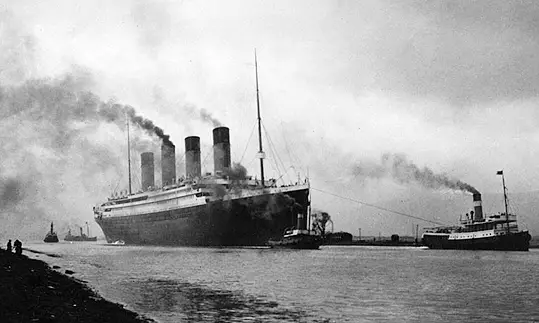
Titanic guided along the Victoria Channel and out towards Belfast Lough for the start of her sea trials, 2nd April 1912. According to Pitman the trials consisted of "just steaming around and performing evolutions... turning circles and adjusting the compass" and lasted "about eight hours".
According to his US Inquiry testimony he "was on the bridge most of the time" and the tests consisted of "just steaming around and performing evolutions... turning circles and adjusting the compass." and lasted "about eight hours" (25.)
Prior to the sea trials he had seen the watertight doors in operation for the first time, stating that "the water-tight doors worked all right…Because I have seen them working. I saw them working at Belfast... Before we went on the trial. I am not very well acquainted with those water-tight doors. It is the first time that I have been with them "(25.)
Also while in Belfast, Pitman along with Fourth officer Boxhall inspected Titanic's portside lifeboats and "found everything that was required. " Lamps along with axes were kept "in the lamp room" and compasses "in a locker on the afterpart of the boat deck." He also counted the lifebelts: " I think about 3,600." (24.)
Southampton
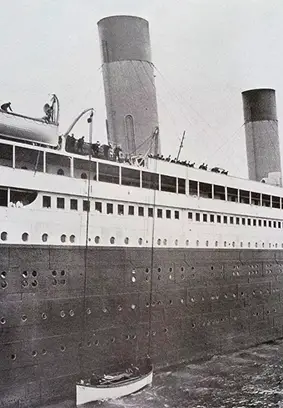
Olympic's lifeboat #9 being tested by the Board
of Trade in 1912 after the Titanic tragedy. It gives
an idea of what the lifeboat tests on Titanic
would have looked like.
With all tests meeting the Board of Trade standards, the Titanic sailed that very night at 8pm destined for Southampton, her port of embarkation, arriving on April 3rd at Berth 44. Although curiously, during questioning at the US Inquiry, Pitman incorrectly recalls the time of arrival as "midnight on Thursday, the 29th of March" after which "she was simply made fast in her berth" and he "kept my usual watch." (25.)
It was not the end of testing though - Pitman was also involved in a test of a starboard lifeboat involving Fifth officer Lowe and Sixth officer Moody while at Southampton:
Mr. PITMAN. Two of them were lowered…Manned... Rowed about the harbor, and sailed back. It is done every trip, and we vary the boats.
Senator SMITH. How many men were in each boat that day?
Mr. PITMAN. Approximately eight...
Senator SMITH. There was no test, then, of the collapsibles?
Mr. PITMAN. No; none whatever…
Senator SMITH. What officers were placed in charge of them?
Mr. PITMAN. The fifth and sixth.
Senator SMITH. Who composed the crews of these lifeboats?
Mr. PITMAN. Quartermasters and sailors. I could not give you their names.(25.)
As the Titanic departed Southampton on Wednesday April 10th, Pitman was assisting (now First) Officer Murdoch at the stern of the ship in supervising the casting-off of mooring ropes and taking on of tug lines. According to historians Charles Haas and John Eaton "Third Officer Pitman, on the docking bridge, passed along instructions to Murdoch in response to the bridge's telegraphed orders." (7.). Hpwever, the position of the the Third officer is normally at the standard compass when leaving port. At the US Inquiry Pitman testified that he knew Murdoch "well" and recalls that during the departure "nothing exciting happened, with the exception of breaking the moorings of the New York, which was caused by the backwash from our starboard propeller. We managed to get clear of that and proceeded to Cherbourg." (25.)
Duties Aboard Titanic
While the Titanic was at sea, Pitman's duties "comprised working out celestial observations, finding the deviation of the compass, general supervision around the decks, and looking after the quartermasters; also relieving the bridge if necessary." (25.)
As a junior officer he shared his watches with Fifth officer Lowe. This included "dog watches" a shift in a maritime watch system that is half the length of a standard watch period which is formed by splitting a single four-hour watch period between 16:00 and 20:00 (4 pm and 8 pm) to form two two-hour dog watches, with the "first" dog watch from 16:00 to 18:00 (4 pm to 6 pm) and the "second" or "last" dog watch from 18:00 to 20:00 (6 pm to 8 pm). The logic behind this is to rotate the watches by creating an odd number of watches in a ship's day and hence avoid the same men being assigned the mid-watch (midnight to 4 am) every night.
Aboard Titanic in practice this meant:
|
Regular Sea Watches |
|
|
First watch |
8pm - Midnight |
|
Middle watch |
Midnight - 4am |
|
Morning watch |
4am - 8am |
|
Forenoon watch |
8am - Noon |
|
Afternoon watch |
Noon - 4pm |
|
First Dog Watch |
4pm - 6pm |
|
Second Dog Watch |
6pm - 8pm |
|
Senior Officer of the Watch |
||
|
Chief Officer Henry Wilde |
2am - 6am |
2pm - 6pm |
|
2nd officer Charles Lightoller |
6am - 10am |
6pm - 10pm |
|
1st officer William Murdoch |
10am - 2pm |
10pm - 2am |
Because of the "Dog Watches", the Junior Officer's watches rotated every two days:
|
Junior Officers - Day 1 |
|
|
4th Officer Boxhall & 6th Officer Moody |
12am - 4am |
|
3rd Officer Pitman & 5th Officer Lowe |
4am - 8am |
|
4th Officer Boxhall & 6th Officer Moody |
8am - 12pm |
|
3rd Officer Pitman & 5th Officer Lowe |
12pm - 4pm |
|
4th Officer Boxhall & 6th Officer Moody |
4pm - 6pm (First Dog Watch) |
|
3rd Officer Pitman & 5th Officer Lowe |
6pm - 8pm (Second Dog Watch) |
|
4th Officer Boxhall & 6th Officer Moody |
8pm - 12am |
|
Junior Officers - Day 2 |
|
|
3rd Officer Pitman & 5th Officer Lowe |
12am - 4am |
|
4th Officer Boxhall & 6th Officer Moody |
4am - 8am |
|
3rd Officer Pitman & 5th Officer Lowe |
8am - 12pm |
|
4th Officer Boxhall & 6th Officer Moody |
12pm - 4pm |
|
3rd Officer Pitman & 5th Officer Lowe |
4pm - 6pm (First Dog Watch) |
|
4th Officer Boxhall & 6th Officer Moody |
6pm - 8pm (Second Dog Watch) |
|
3rd Officer Pitman & 5th Officer Lowe |
8pm - 12am |
His duties did not include being in charge of the ship's log - "the fifth and sixth usually keep that... We keep two or three. The scrap log is kept on the bridge; the fifth and sixth look after that. The chief officer’s log is copied from that... The fifth and sixth keep the scrap log, as everything happens on the bridge, alterations of courses, deviations, and that sort of thing, and it is copied from there into the chief officer's log, which is really the official log." However none of these logs were saved as Pitman, under questioning at the US Inquiry responded: "We had something else to think of besides log books, sir." (25.)
Pitman recalls the water temperature being tested during the voyage. Under questioning he said "it is a custom in the ships…And it is for meteorological observation... They are made every two hours... the quartermaster does that every two hours." Although he had not personally seen it being done, he had " seen the men going to do it…We usually have a canvas bucket which they lower into the water... We did not have time to make one. They were using a tin... [and] a piece of rope long enough to reach the water." (25.)
But Pitman did not believe there was necessarily a connection between ice and any change in the temperature of the weather stating that such a change "would not denote anything at all…because in this country and in our own country we will probably want no clothes on at all, and the next day we will want overcoats, winter clothes, and that is not due to ice." (25.)
Pitman had seen ice before in the southern ocean "about 18 months ago, and there were three [icebergs], as a matter of fact... off the Falkland Islands. One was about 700 feet long and 600 feet wide and fully 500 feet high... we did not expect to see ice." Interestingly Pitman noted that it was about a mile away and spotted "in the morning, about 8 o'clock... When the sun was shining on it, it was a perfect white." However at night "when the sun was not shining on it, it looked like a perfectly black berg, like a huge island, and that is where I proved that the temperature of the water is absolutely no indication of icebergs... It did not affect the temperature in the slightest." (25.)
Ice Warnings
According to his testimony at the US Inquiry, on the night of Saturday April 13th, three days into the voyage, Pitman vaguely recalls Fourth officer Boxhall noting ice on the chart. He stated:
"I heard something about a wireless message from some ship... I was not on watch...; it was either Saturday night or Sunday morning... Mr. Boxhall put on the chart the position of the iceberg... He would just simply make a cross and write "ice" in front of it…As far as I can recollect, it was to the northward of the course; to the north of our track... I did not measure it, sir; and I have not the slightest idea of the position of it." (25.)
However, later at the British Inquiry he changed his recollection about Boxhall marking the chart on the Saturday and instead mentions seeing one or possibly two Marconigrams mentioning ice on the 14th in the chart room.
"We knew that we should be in the longitude of ice," he said. " I saw it in a Marconigram... I simply looked at them and saw that there was no ice reported on the track." He added that there were "two, I think" in the chart room, but there was no discussion between the officers regarding them. He later testified "I read one" but cannot remember what was on the other as he did not read it. The one he read stated "“Ice in longitude 49 to 51 W.” He presumes the message arrived on the Sunday as "had it come on the Saturday I should have seen it before." (24.)
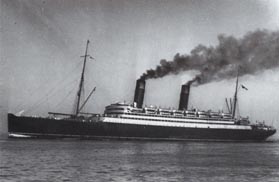
The only ice message Pitman could recall
was from the RMS Caronia.
Regarding the US Inquiry memory of ice being marked on the chart on Saturday, he testified: "That is a mistake. It is Sunday night." and adds that ice was marked "on the North Atlantic Track Chart... Some miles north of it... as far as I can remember, one was put on the chart between 4 and 6….it was either Mr. Boxhall or Mr. Moody. Mr. Boxhall does not seem to have any recollection of it, so it must have been Mr. Moody. I saw it there when I came on deck at 6 p.m." (24.)
Later in his testimony at the British Inquiry he clarified regarding the ice messages: "I can only recollect one... only one; that is the “Caronia” message." (24.). Although as this was the same occasion that Second officer Lightoller also recalled the "Caronia message" it is quite likely his recollection is based on Lightoller's evidence.
Concern for Passengers
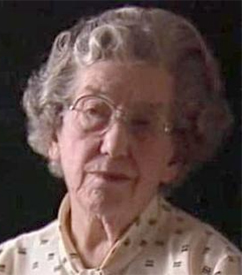
Eva Hart was 7 when she recalled an
officer - either Boxhall or Pitman,
concerned about her mother.
Seven year old Second-class passenger, Eva Hart, recalled an officer who had noted her mother's anxiety about being at sea, who she also met at the time of the making of the British film "A Night to Remember" (1958), meaning the officer was either Fourth Officer Boxhall or Third Officer Pitman:
One of the ship's officers was particularly pleased to see us all together at lunch and came over to speak to mother.
'Does this mean that now we are getting across the Atlantic you have got over your fears?' he asked. Have you finished sitting up guarding us at nighttime?' The remark was not intended unkindly, but no member of a ship's crew is anxious to have passengers who are worried about the safety of the ship, as this can upset other passengers on board.
'Oh no, I'm going to bed now' she replied.
The officer patted her on the shoulder and said light-heartedly, 'Ah, well, we shall be quite safe if you look after us again tonight.'
Many years later, that same officer reminded me of the conversation he had had at our lunch table, as he was one of the survivors who lived to see the making of the film A Night to Remember. (“A Girl Aboard the Titanic: A Survivor's Story”, Eva Hart, 2000)
6pm Watch: Observations and Speed
According to Samuel Halpern's Titanicology website, Pitman was in charge of the "port watch" and hence on the evening of April 14th was on the second "Dog Watch". He explains:
The Junior Officers on board Titanic were required to keep “watch-and-watch” with the Able-Bodied Seamen. Third Officer Herbert Pitman was in charge of the “port watch” and was paired with Fifth Officer Harold Godfrey Lowe. Fourth Officer Joseph Groves Boxhall was in charge of the “starboard watch” and was paired with Sixth Officer James Moody. What this meant was that each watch section, port and starboard, worked 4 hours on and then had 4 hours off. To ensure that the same watch section didn’t have to work the same hours every day, the 4 hour period from 4 p.m. to 8 p.m. was divided into two Dog Watches of 2 hours each. (http://www.titanicology.com/WatchTablesFile.htm)
Hence Pitman's watch was from 6pm to 8pm. When he arrived for his watch he firstly had dinner "At 6 o'clock….just after I went on the bridge and left the bridge, then I had my dinner." in the officer's mess on the boat deck. (25.)
During the rest of his watch, Pitman was primarily involved in calculating Titanic's speed and distance.
“Third Officer Pitman, who also had come on duty at 6: 00, monitored the chronometer, noting the instant when Lightoller called out “time” so that the position of the ship could be calculated on the basis of celestial observations. Pitman then headed to the chartroom to determine their exact position, noting that they were not particularly near the ice floes for which they had received only minimal information. Later, when Third Officer Pitman and Fifth Officer Lowe completed the Second Dog Watch at 8: 00, Pitman handed over the uncompleted computations to his replacement for the next shift, Fourth Officer Boxhall.” (Titanic Officers and a Gentleman) (61.)
It is interesting to note during the US Inquiry that Pitman calculated Titanic was making 21½ knots – “nothing like we expected her to do.” He states that he made the "stellar observations... Between half past 7 and 20 minutes to 8." with Second Officer Lightoller, and they took "a set of sights." Upon mentioning that he "thought it quite possible that she could reach 24" knots he added that they were not trying to do so as they "had to study the coal. We had not the coal to do it."
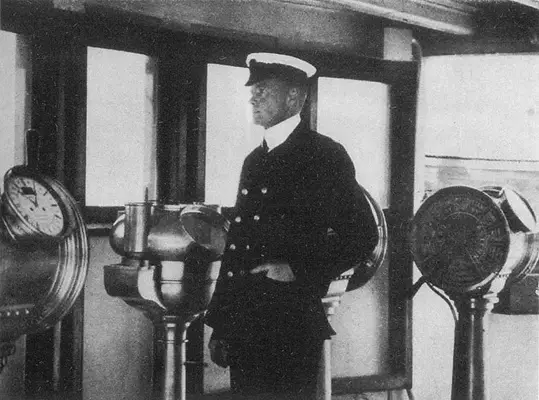
Lightoller on the bridge of the Oceanic, 1910. Pitman worked with Second officer Lightoller during his 6pm-8pm watch. (Click to enlarge)
The calculation of 21 1/2 knots as Titanic's speed was based on the "log and the revolutions." and Pitman said these were "about 75... She never exceeded 76 revolutions at any part of the trip." (25.))
Pitman later explained that he "took stellar observations and also observations for compass deviation... I did not take the stellar observations myself. I took the time for them, and Mr. Lightoller himself took the observations of the body... We just took a set of them at sunset, or just as it was getting dusk, when the stars were visible. It was about 6 or 8 o'clock that we took them." These observations located the ship "right on the track."(25.)
Pitman's Corner and End of Watch
According to his testimony at the British Inquiry, Pitman also noticed, when he calculated their position on 14 April, that Captain Smith had delayed the northward turn toward New York by about ten miles. This has been explained as being in order to bring the ship further south and thus lessen the risk of meeting ice.
However this firstly does not align with his first testimony at the US Inquiry, which is as follows:
Senator FLETCHER. Do you know any such designation as the "corner?"
Mr. PITMAN. Yes, we were supposed to be at the corner at 5.50.
Senator FLETCHER. What do you mean by that?
Mr. PITMAN. That is 47° west and 42° north.
Senator FLETCHER. At 5.50 p.m. you turned what you call the “corner?''
Mr. PITMAN. The corner, yes.(25.)
As Samuel Halpern writes on his Titanicology website "Third Officer Herbert Pitman and Fourth Officer Joseph Boxhall both had testified at the American Inquiry to the effect that the Titanic altered course toward New York at 5:50pm on April 14. Neither one of them mentioned anything about the turn being late."
The different account took place at the British Inquiry:
15173... (To the Witness.) Do you know at what time the course that the steamer was to take was mapped out that day? – [Pitman] Yes, noon.
15174. And, so far as you know, was the steamer's course deflected at all from the course that had been marked out at noon; did it vary to the south, or in
any way from the course which had been marked out at noon? - Yes, I considered we went at least 10 miles further south than was necessary...
15182. But you say he gave instructions to alter the course of the ship? - The course was altered at 5.50. They were the Commander's orders.
15183. Ten miles further south. Was any record made of that at the time? - No, and I thought that the course should have been altered at 5 p.m.
15184. Why did you think so? - Judging from the distance run from noon...
15214. In your opinion did she change her course sooner or later than she ordinarily would have done. She changed it, you know, at 5.50? - That was later.
15215. Then, in your opinion, had she gone in a south-westerly direction longer than she ordinarily would have gone? - I thought she had gone for three-quarters of an hour longer on that course than she should have done.(24.)
According to Sam Halpern, "an expected arrival time at the “corner” between 5:00 or 5:05pm is truly ridiculous. Since we know that the “corner” was about 126 miles from the ship’s noontime position, a distance easily calculated by subtracting the distances of the ship's known daily runs from the total distance from Daunt's Rock to the “corner,” a speed in excess of 25 knots would have to have been achieved."
Halpern explains that "the reason for coming up with the delayed turn story can be traced back to the erroneous CQD position worked out by Boxhall... So where did Mr. Pitman get his 5:00 to 5:05pm expected time of arrival at the “corner” from? That answer turns out to be quite simple. Pitman simply started from Boxhall’s CQD position at 41° 46’N, 50° 14’W, and worked the problem backwards…At 22 knots, it would take Titanic just about 5 hours and 4 minutes of steaming to cover that distance."
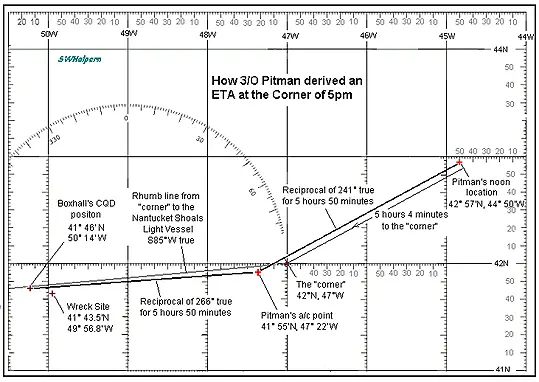
Pitman's incorrect calculation that Titanic had turned the corner early at 5pm instead of 5.50pm is due to him using Boxhall’s CQD position at 41° 46’N, 50° 14’W, and working the problem backwards as shown in this graphic by Sam Halpern (Click to enlarge) (Source: http://titanicology.com/Titanica/PitmansCorner.html)
As it happened, Pitman never finished his calculations. He explains he was " working out the observations… In the chart room; in the chart house… I was there alone until 8 o'clock… I did not finish them. Mr. Boxhall took on then and finished them… .I simply said "Here is a bunch of sights for you, old man. Go ahead." (25.)
Although Pitman "can not remember it exactly." He thinks that the officers discussed the possibility of ice on the "Sunday. It might have been about 8 o'clock. I do not remember the time... we were just remarking that we should be in the vicinity of ice in Mr. Murdoch’s watch... I can not remember now, sir, when it occurred, and I have not now the slightest idea who was there... I just heard the remark passed; that was all." (25.)
Having finished his watch Pitman "went to bed... Within a very few minutes." (25.)